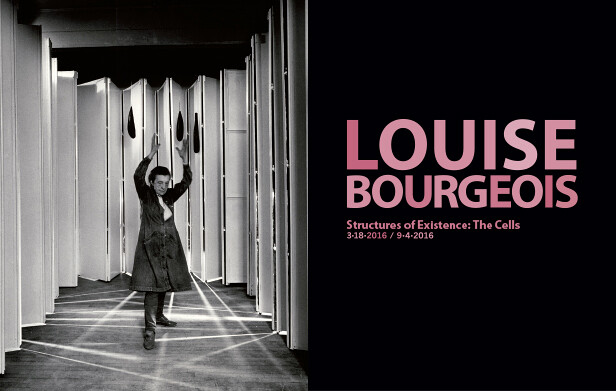March 18–September 4, 2016
Curators: Julienne Lorz and Petra Joos
Sponsored by Fundación BBVA
The Guggenheim Museum Bilbao is pleased to present Louise Bourgeois: Structures of Existence: The Cells, an ample selection of the innovative, sophisticated sculptural works developed by Louise Bourgeois (1911–2010) over the course of two decades. In this exhibition, organized by Haus der Kunst, Munich, in collaboration with the Guggenheim Museum Bilbao, visitors will be able to discover and experience 28 emotionally charged architectural spaces, each an individual microcosm separating the internal from the external world, by one of the most influential artists of the 20th century.
Louise Bourgeois’s concepts and formal inventions, such as her engagement with psychoanalysis and feminism, and her use of environmental installation and theatrical formats, have since become key positions in contemporary art. A prime example of this is the “Cells,” a series comprising approximately 60 unique pieces that Louise Bourgeois began in 1986 with Articulated Lair.
This exhibition reunites Cells I to VI for the first time since 1991, when they were first shown at the Carnegie International in Pittsburgh. The term “cell” originated during the preparations for the Carnegie show. For Bourgeois, this word had many connotations, as it refers to the biological cell of a living organism as well as the isolation of a prison or monastic cell.
Three years later, in 1994, the artist produced her first spider sculpture. Although Louise Bourgeois was already over 80 years old at the time, she once again succeeded in reinventing her working methods and went on to create some of her greatest works, aided by the acquisition of her first large studio in 1980. Up to that point she had worked in her Chelsea townhouse, where the size of the rooms—barely four meters wide—conditioned the dimensions of her sculptures. Her new studio in Brooklyn paved the way for large-scale works.
The “Cell” series revolves around the desire to simultaneously remember and forget. “You have to tell your story and you have to forget your story. You forget and forgive. It liberates you,” Louise Bourgeois once claimed. In this respect, the “Cells” contain references to individuals and experiences from the past. The needles, thread, and spindles incorporated in these works allude to the artist’s childhood and her parents’ work—Bourgeois’s mother restored valuable tapestries.
The “Cells” also speak of abandonment, betrayal, and loss, rooted partly in the strain under which the Bourgeois family lived for years. Louise’s father had an ongoing affair with the family au pair, Sadie, who lived in their home for nearly a decade. Furthermore, in a reversal of conventional roles, Louise had to nurse her mother, who contracted a serious illness and asked Louise to help keep her worsening condition a secret from her husband. Louise thus found herself entangled in a web of conflicting emotions: admiration and solidarity, anger and powerlessness.
As a new sculptural category, Louise Bourgeois’s “Cells” “occupy a place somewhere between a museal panorama, a theater set, an environment or installation which, in this form and quantity, is without precedent in the history of art” (Julienne Lorz).
For more information:
Guggenheim Museum Bilbao Communication and Marketing Department
T +34 944 359 008 / media [at] guggenheim-bilbao.es
All information about the Guggenheim Museum Bilbao is available at www.guggenheim-bilbao.es (press room).


